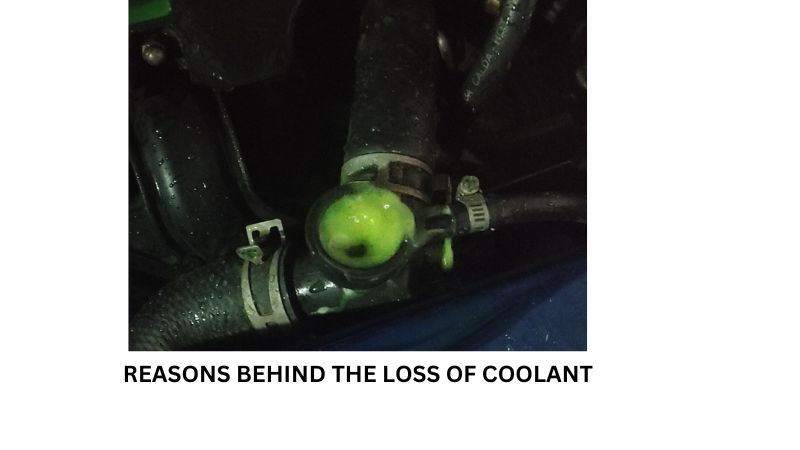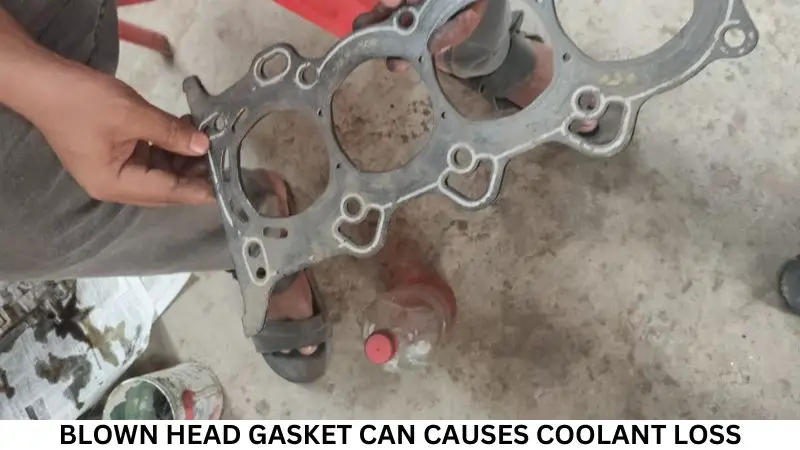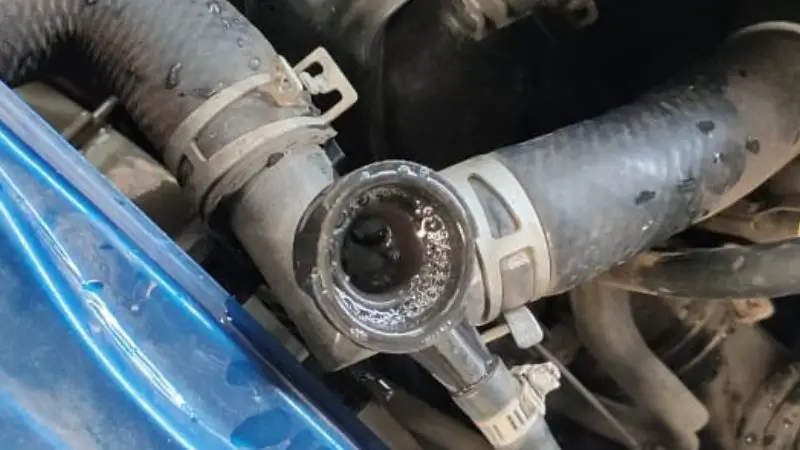To run your vehicle correctly, like fuel, you need a car coolant. It would help if you had this antifreeze liquid because after driving a car, your engine will warm. But after facing the coolant loss problem, you may wonder how much coolant loss is normal. A well-maintained vehicle can lose two or three ounces of coolant every year.
It is usual for Zero to lose a few ounces of coolant each year due to freezing temperatures or evaporation. But, if your car’s coolant loss exceeds this, you should consider any problem. Continue reading to learn more about this problem and dispel any misconceptions.
Causes Of Coolant Loss
There are many reasons behind the loss of coolant, and some causes are:

- Worn-out The Head Gasket
Head gasket and coolant levels are related. Due to insufficient coolant, the head gasket will damage. Also, the coolant is dangerously missing due to a worn head gasket.
Coolant can enter the engine’s combustion chamber if a worn-out head gasket is in place. And it can damage the cylinder head or engine block. This is when you sometimes see white smoke coming out of the engine.
- Faulty Radiator Cap
A radiator cap’s primary function is to allow the maximum coolant flow rate by maintaining an adequate coolant level. Nonetheless, the reservoir pressure will drop due to a faulty radiator cap in place, causing the coolant to flow faster.
As a result, the coolant level will be low. Therefore, checking or replacing the radiator cap once every 2 to 3 years is always good.
- Radiator Leak
The radiator is created from portable aluminum and is a perfect choice for several reasons. It is only the radiator that is surrounded by high temperatures. Since the coolant is somewhat costly, some people switch to a lower-grade coolant or use water instead. Both begin to corrode the radiator walls and eventually create holes, causing coolant leaks.
- Radiator Hose
Since a radiator hose is positioned relatively close to the engine, it can carry heat from a running machine. Because of this, hoses are prone to cracking and leaking coolant. If coolant spillage continues, it affects the head gasket and results in engine failure. Finally, these are some common reasons behind vehicle coolant loss over time.
How Much Coolant Loss Is Normal?
A coolant leak is bound to occur with problems within the engine. But the coolant level may be dropping without any sign of a leak. A minute amount of coolant can evaporate because it is not a completely closed system.
Without mechanical errors in your cooling system, coolant levels will drop slightly over time. You can expect a coolant loss of 0.25% every 4-6 months, and your engine will run well without leaks.
That means two to three ounces of coolant loss a year is typical. However, anything above that can occurrence an ample coolant leak. That’s why you should investigate the issue further.
How Much Coolant Loss Is Normal In Diesel?
In your diesel engine, normal coolant consumption is zero. If your coolant is going down, that means something is wrong. You should check everything carefully. To check it, first, you should check the hoses and coolant smell in your car. The leak will be your diesel heater core.
Overfilling is another way to lose coolant. Remember that don’t fill the coolant reservoir on a cold engine. Look carefully; a maximum fill line should be around the power’s midpoint.
How Much Coolant Loss Is Normal In Summer?
It’s normal for your car to lose some coolant during the summer. You won’t experience a significant drop in coolant levels at any time of the year. It’s also understandable that your engine constantly overheats a little at high speeds.
Coolant Leak Symptoms:
In many ways, you can know about coolant leaks. Let’s discuss the coolant leak symptoms in detail:
Overheating Engine
If your car’s temperature warning light is on, it means your vehicle is overheating. And after adding a coolant, if this light is on, it means your coolant is leaking.
The primary purpose of adding coolant to an engine is to lower its temperature. If it leaks, your car will heat up quickly, even if you drive briefly.
Bubbles In the Radiator
The radiator pipes and coolant expansion tank are tightly closed to prevent air from entering. However, combustion air will take up this space if your coolant leaks.
This way, you can understand bubbles in the radiator or expansion tank. This is a sign of a coolant leak, even if you have recently added coolant. Take your vehicle to a mechanic immediately to inspect the issues of the leak.
Seeing a Coolant Pool
Your vehicle may have a coolant leak if you notice a pool of coolant under the vehicle. In Particular, you may notice it after parking your car for a long time. After a few days, if you see a big coolant pool, it means your coolant is leaking too much. So you should be concerned about it and fix it immediately.
Low Coolant Level In The Expansion Tank
Every vehicle comes with an expansion tank to store the coolant. If the engine coolant runs low, the car refills from the expansion tank. If your car is overheating, it uses all the coolant in the expansion tank.
Therefore, after refilling your expanding tank, there is a coolant leak if you see it’s empty. Contact a service center immediately to resolve the situation because a coolant leak can cause engine failure.
Causes Of Coolant Leaks:
If you find a more significant coolant leak, you can use K-Seal or K-Seal Ultimate to stop the leak quickly.
The coolant leaks leading causes are:
- A faulty radiator cap
- Pulling weighty loads
- Overfilling the coolant system
- A leak that comes and goes
- Worn radiator hoses
- A cracked engine block or cylinder head
- Blown head gasket

When you notice the above things, it could cause your coolant to leak. Aside from towing problems, taking your car to your mechanic will be a good idea.
For example, your car engine immediately seizes if you have a blown gasket. And, if you don’t check out your radiator, you could find yourself stranded on the roadside.
Losing Coolant No Leak, No Overheating?
Depending on the vehicle’s model and make, steam may leak from the radiator or overflow cap. You should really hope that this is all because they are cheap to replace. And you can fix your coolant leak problems in minutes. It’s best to replace both caps and check if that sets for difficulties.
Moreover, you can check your coolant overflow tank for pinhole leaks. If coolant systems cannot maintain pressure because of a hole in the coolant tank, you can notice overheating.
Unfortunately, if it doesn’t work, you may have a head gasket that is leaking. Depending on the car’s age, you should make some serious decisions for a bright future with the vehicle.
Head gasket replacement is expensive. And you can’t do it yourself because the block and head have already warped because of overheating. To fix this problem, begin with a cap and then a tank. And be ready for something serious if they don’t solve your problem.
How To Fix Coolant Loss
You can fix your coolant or any losing problem. In most cases, you can solve it yourself. Other times or for significant issues, you need to help. However: here we give some solutions that will help you to fix the coolant loss:
Find and Repair Coolant Leaks
Before stopping the leaking problem, you first need to find it. The easiest way to catch a coolant leak is if there is an external drip. Take a large cardboard piece and put it under your car at night. And see if there is a fall of any coolant or not to determine the problem.
Test Head Gasket
Testing for blown head gaskets takes work. For this reason, many people choose to look for symptoms first to see if head gasket failure is possible. For example, when the head gasket is to blame, you may see coolant in the oil or vice versa. There should be white smoke coming from the exhaust. If the symptoms lead to a blown head gasket, take your inspection to another level.
Coolant Leak Sealer
You can use a cooling system or radiator sealer if you have a leaking radiator, hose, or gasket. These products add a chemical to the system wall covering small holes. Besides, these products are relatively easy to use and do not cost much.
Contact Auto Professional
If you feel overwhelmed at any point in these steps, you will do well to contact an auto repair shop. Cooling system problems are only sometimes easy to diagnose or repair, so don’t fixes any unprofessional. For example, repairing a blown head gasket is a difficult task. For this reason, to fix this problem, you should get more guidance.
The price of repairing cost depends on several factors. Prices vary based on your car type, the shop’s location, and what must be fixed. In most cases, it should take a mechanic an hour or two to determine the problem unless it’s complicated.
Coolant Loss With AC On
Sometimes coolant doesn’t leak when AC is on, Usually, it could be condensation from the AC. which isn’t a problem. But as the coolant function, the cooling piping feeds the AC. If it’s actually coolant, your engine is working harder and overheating.

FAQ (Frequently Asked Questions):
Q. How to stop a coolant leak?
It’s best to carry a small tool kit in your car to repair anywhere quickly. Mainly, if your engine hose connections are loose on the road, it can save you from getting stuck.
With some of the ways, you can stop coolant leaks.
- Install the new radiator hose.
- Purchase new radiator hoses after some years and ensure they are compatible with your car model.
- Replace the radiator cap.
If your radiator cap is rusted or damaged, replace it to prevent further leaks.
- Repair the radiator.
Take your car to a mechanic and have the radiator holes sealed to prevent leaks. Unfortunately, with a leak or hole radiator, you can’t drive your vehicle.
- Replace the water pump.
Since replacing the water pump can be difficult, you must do it when changing the timing belt.
Q. Can you drive a car with a coolant leak?
We would strongly recommend against it. Don’t drive your car to avoid damage if you have warning signs. If you drive your vehicle with warning signs, you will experience expensive repairs.
It’s completely understandable if you need to drive to a mechanic to cool the leak repair. It just ensures that you keep an eye on your coolant level. In addition, if your coolant level drops more quickly, there is a severe internal coolant leak. It would help if you fixed it quickly.
Q. Why is my car going through coolant so fast?
A car going through coolant quickly is a problem that can cause engine damage. Likewise, if don’t address, it leads to costly repairs. Coolant is vital in keeping the engine cool and preventing it from overheating. Furthermore, if your car is going through coolant quickly, it could be for several reasons. The reasons are:
- Leaks in the cooling system
- A faulty radiator cap
- A blown head gasket
- A cracked engine block
Identifying the root cause of the problem and taking steps to fix it immediately is essential.
Final Word:
In summary, this is the article where we have discussed how much coolant loss is normal in detail. However, losing coolant anywhere from zero to a few ounces per year is typical. Ultimately, it’s abnormal if you notice more than a cup of coolant loss every six months.
The best coolant means it’s non-toxic, prevents corrosion, and has a high heat capacity. Buying the proper coolant and monitoring the coolant level is essential to avoid further damage. At last, do you have any questions about this topic? Comment your questions, and let us know how we can help you.
Read Also: Can You Use Water As Coolant?

